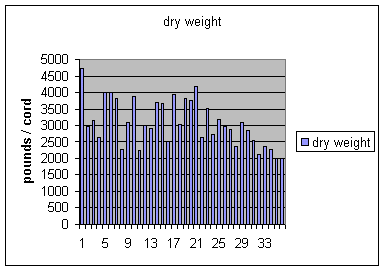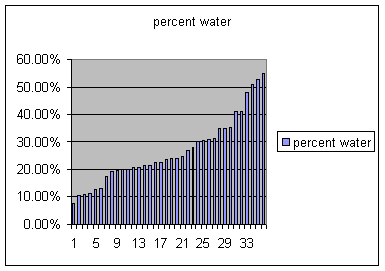 Stimulating
Understanding of
Computational science through
Collaboration,
Exploration,
Experiment, and
Discovery for students with
Hearing
Impairments
Stimulating
Understanding of
Computational science through
Collaboration,
Exploration,
Experiment, and
Discovery for students with
Hearing
Impairments
 Stimulating
Understanding of
Computational science through
Collaboration,
Exploration,
Experiment, and
Discovery for students with
Hearing
Impairments Stimulating
Understanding of
Computational science through
Collaboration,
Exploration,
Experiment, and
Discovery for students with
Hearing
Impairments |
a collaboration of the Shodor Education Foundation, Inc., Eastern North Carolina School for the Deaf, Barton College, the National Technical Institute for the Deaf, and
Interpreters, Inc.
|
For Teachers!
Answers to questions.
What more can I learn from my tree?
You have found the answer!! You have an estimated green weight for your tree. Answers are nice but the nice feeling only lasts a little while. The real excitement is in the exploration and discovery. Scientists want to jump right back into the science so they won't get bored. The scientists look at their answers and try to find new questions to explore in them.
Can we find any questions in our tree's green weight? First, what does green weight mean?
When trees are alive their cells, like yours, have water in them. When the tree is cut down the wood dries out. Green weight is the weight of the tree when it is alive.
Our bodies are mostly water. The average adult human body is about 50 to 65 percent water. A childās body is closer to 75 percent water. We have different body types. Some of us have more muscle, others more fat. Some look like they are mostly skin and bones. That is why the percentage of water can vary so much. Trees also vary a lot between species. Some trees are tall and thin like many pine trees. Other trees develop broad crowns like oaks. After you get to know a type of tree you can often identify them from a distance by their shape. You can probably do the same thing with your human friends.
The percentage of water in trees also varies. A tree can be more than one half water. Scientists have measured the green and dry weight of many different kinds of tree. The
"dry/green" weight table gives the moisture content for different kinds of trees.
To find the dry weight of your
tree, multiply its green weight by the dry/green ratio.
You can use your calculator or our online dry weight calculator.
Once again you have an answer. Really we have a whole table full of answers.
Can you find a relationship between the dry weight of a tree and its percentage of water?
I made a spreadsheet with data from the
Ratio of dry weight to green weight page. I sorted the data by percent water and made these graphs. There isn't an obvious trend. Many questions don't give us the answers we expect. Since there isn't a pattern we should ask why there isn't. If trees become completely saturated with water they sink. The reason they float is that the heartwood is dead and the cells have "air" in them. When these balloons fill with water the log sinks. The percentage of water relates to the percentage of cells that have water in them and how much water they contain. The dry weight of a tree is related to the ratio of cell wall to empty space in the cell. In
green weight the dominant factor seems to be the percentage of cell that are filled with water. There is a slight trend for heavy trees i.e. trees with relatively thick cell walls to interior ratios, to have less water. All other things being equal that makes sense, but most of the time the other things aren't equal.


It is good for students to see that scientific explorations don't always proceed directly to the expected results. Even unexpected results are opportunities to gain insight.
Chemicals in trees
Trees are 50% to 53% cellulose. Cellulose is a polymer of sugar. Many sugar molecules are stuck together in a network to form cellulose. Animals canāt break the cellulose down into sugar again. Some bacteria can break down cellulose.
Cows and termites have these bacteria in their digestive systems. That is why cows can eat grass or even paper.
Another 1% is minerals. The minerals are the ash you have after you burn wood. The minerals are elements like calcium and iron.
The rest of the tree is lignin and some cytoplasm chemicals. Lignin is a group of protein chemicals that act like glue to help hold the cell wall together.
When chemists analyze wood they find that 50% of a treeās dry weight is carbon. Find the weight of carbon in your tree by multiplying the treeās dry weight by .5. Check results with CO2 calculator.
The tree got its carbon from CO2 in the air. We can ask how much CO2 has the tree sequestered from the atmosphere?
Find the weight of CO2 that your tree has sequestered.Check results with CO2 calculator.
Cars produce CO2 by burning gasoline. For each gallon of gasoline burned 20 pounds of CO2
are produced. When cars burn gasoline they put CO2 into the air. When trees grow they take CO2 out to the air.
Calculate how many gallons of gasoline the carbon in your tree is equivalent
to. Check results with CO2 calculator.
People produce CO2 in a variety of ways. We can explore several of these carbon pathways.
Now that you understand the algorithm we can put all of these calculations together in a computer model. Then we can explore the relationship
between of human production of CO2 and trees' ability to sequester it and the computer will do our calculations.
Find the miles per gallon for several cars,
motorcycles. The average household drives 20,895 miles per year. Calculate the number of trees needed to sequester the CO2 produced by a family using these different kinds of transportation.
http://www.fueleconomy.gov/feg/findacar.htm
http://www.epa.gov/globalwarming/tools/wc_assum.html
On average electricity production in the US produces 1.64 pounds of CO2/kWh. Find the number of kilowatt hours that the power plant can produce when it produces the CO2 your tree has sequestered. Compare this to the number of kilowatt hours your family uses in a month. How many months of electricity is your tree equivalent to.
How many kilowatt hours of electricity do the lights in your classroom consume in a day, week, month, year?
Read the wattage on
one light bulb or tube in your class. Multiply that by the number of bulbs in the class. Multiply that by the hours per day the lights are on.
Divide that by 1000 to change from watts to kilowatts. (w X #bulbs X hours)/1000 Multiply this by days per week the lights are on or days per month or days per year.
How many kilowatt hours of electricity does your school consume in a month, year?
The students can start with the values above and extrapolating to the school. They
need to include electricity used for computers, AC, etc. That list
will inevitably be incomplete so getting a copy of the electricity bill from the principal may be a better strategy. Still that is an estimate because the usage varies from month to month. This presents an opportunity to discuss evaluating different strategies.
How many trees is this equivalent to? Multiply you
kWh used by 1.64 pounds/kWh and the kWhs cancel. Divide the pounds of CO2 your school's electricity
produced by pounds per tree. The pounds cancel and you have the number of trees.
kWh X pounds/kWh, pounds/(pounds/tree)= trees
Natural gas produces .12 pounds of CO2/ft3. Fuel oil produces 22.29 lbs of CO2/gal.
Is your home or school heated with natural gas or fuel oil? If it is how many trees would be needed to sequester this CO2.
Same idea as electricity but substitute gallons of fuel oil for kwhr and 22.29 pounds for 1.64 pounds.
We have calculated three different weights for your tree: the weight above the ground, the weight of the roots, and the total weight to the tree.
Which of these should we use when we consider the trees contribution to our air?
Answers will vary. The bottom line is
we don't have enough information at this time to have a definitive answer. That is a good thing because, as scientists, we have a good question that we can explore.
Every year you tree absorbs carbon to make its trunk larger and also to make new leaves. The carbon stays in the trunk. The carbon in the leaves returns to the air when the leaves rot the next year. Eventually your tree will die or get cut down.
What will happen to its carbon then? How can we evaluate a treeās or forestās long term ability to counteract the CO2 we are putting into the air?
Again the answers will vary and we need to explore more models before we can draw conclusions.
The module ćForests, Mining Carbon from the Airä will help you explore these issues.
 The Shodor
Education Foundation, Inc.
The Shodor
Education Foundation, Inc.
Copyright © 1999-2001 by The Shodor Education Foundation, Inc.
|
by the National Science FoundationOpinions expressed are those of the authorsand not necessarily those of the National Science Foundation. |

|